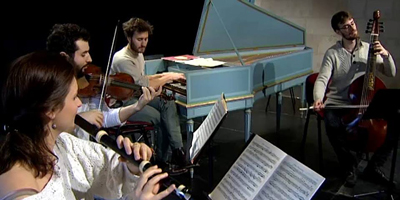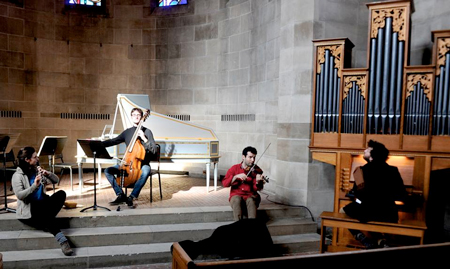by Daniel Hathaway

The program began charmingly as the members of the ensemble introduced themselves one by one using the Largo from Jean-Baptiste Quentin’s Concerto for four parts, Oeuvre XII. First to appear was keyboardist Jean Rondeau, playing the continuo line on the small Brombaugh organ at the front of the nave. Moving down the aisle, viola da gambist Robin Pharo took his place next, followed at intervals by violinist Louis Creac’h, and flutist Anna Besson, each adding a layer to the musical fabric until all four were in place.
A masterful way to begin, the Quentin gave an early sense of the ease and naturalness Nevermind brings to the French Baroque repertoire. Its style is often so ornate that players can get lost in its surface complexity. As the program continued, Nevermind validated the initial impression that this is a group that listens intently to each other, respects every individual’s role in the ensemble, and communicates the beauty of the music directly to the audience without the kind of artificial, affected gestures adopted by some ensembles that only get in the way.
These players are also disarmingly relaxed and unpretentious. Besson set up that mood with her opening remarks, telling us that there would be a “little change” to the program order. She rattled off those details so quickly that listeners weren’t quite sure what they had been hearing until they compared notes at intermission. Never mind! It’s fun being lost in the woods without a GPS when the playing is so enthralling that you don’t need to keep checking your bearings against the printed program.
For the record, the ensemble began with the Sonade from François Couperin’s “La Piémontoise” (Les Nations, 4ème ordre) and continued with Quentin’s Quatuor from Sonata III, Oeuvre XV. Early on, Robin Pharo’s bow suddenly fell apart, which brought everything to a halt and inspired some informal repartée. “At least it wasn’t the viola da gamba,” Besson said while Pharo went off to grab a spare. Good thing too, for his elegant 17th-century instrument was a loaner from Oberlin professor Catharina Meints’ collection. Pharo calmly dusted himself off and the ensemble went back to the beginning, this time without incident. (Elsewhere, Pharo played some repeats pizzicato, a refreshing technique rarely used on the gamba.)
Following intermission, Nevermind played not the listed New Parisian Quartet by Georg Philipp Telemann, but another one in b-minor. Like a jazz piece, the quartet gives each player a solo break, an opportunity for the audience to revel in the individual artistry of these four young baroque wizards. Elegantly-managed pauses were nearly as expressive as the notes they separated.
The concert ended with what had been listed as the second piece, Louis-Gabriel Guillemain’s Sonate en quatuor No. 3, Op. 12. By far the most characterful work on the program, the Guillemain featured stormy scales, lovely expressive harmonies and extravagant sequences. Harpsichordist Jean Rondeau was both an equal partner in his robust continuo realizations, and an impressive collaborator who had much of the music memorized — he spent long stretches turned toward the other players keeping an eagle’s eye on their every nuance. Rondeau also offered up a curious verbal program note. “The only thing we know about Guillemain is that he was murdered, stabbed 27 times.”
The audience didn’t want to let the evening end, and their ebullient ovation inspired two extra pieces from Nevermind. The first, an Irish lament followed by a Scottish reel, featured sultry flute playing from Anna Besson and eventually a spirited Highland hoedown from everyone. The second was the final movement from the originally-listed Telemann quartet (No. 6 in e-minor). Hauntingly beautiful and valedictory, it called for future, regular visits by this stunning ensemble.
Photos by Michael Lynn.
Published on ClevelandClassical.com February 27, 2016.
Click here for a printable copy of this article




